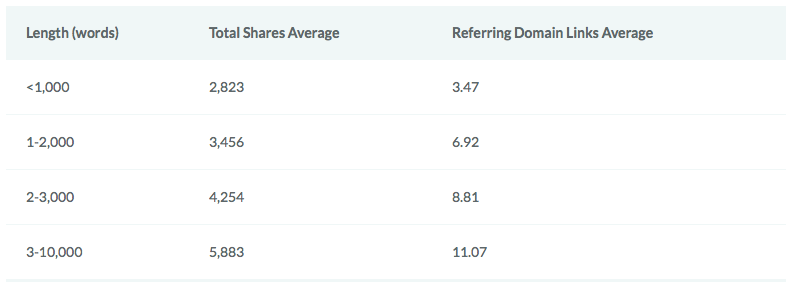Of course, some businesses will suit certain content types more than others (your local bakery, for instance, probably won’t need to produce a series of white papers on optimum baking techniques whereas a few videos on methods and a recipe download might be perfect). That’s why we’ve created this guide to help you determine which content marketing mix is best suited to your business.
Who’s your audience?
Before going any further, you need to understand who you’re creating your content for. Without this knowledge, it’s impossible to know what they’ll find interesting. If you’re starting out fresh and don’t know what your audience will interact with, you can get an idea of what’s likely to work by reviewing your competitor’s content. What works for them is likely to also work well for you, and if you can spot some gaps you’ll be able to bring something unique to the table.
Bitesize Portions – Short Content
People have short attention spans, and unless they’re already engaged with your brand they’re unlikely to dedicate much time to reading what you have to say if it isn’t exactly what they’re looking for. In fact, many publishers have found that users spend much less time reading their content than you’d think. According to Chartbeat’s analysis of reading habits (from 2013 but still true today), a third of readers will never make it further than ‘the fold’. Therefore, quick, interesting articles that provide value are a great way to reel in new readers, and help to promote your more in-depth content.

A great example of this is the ubiquitous “list” post. The big attraction of these articles is that they communicate how short they are before they’re even clicked on; the title “Top 3 Content Writing Tips” tells the reader exactly what they’re going to get. They’re easy to digest, but you can still pack in some useful content – our “5 Fantastic Free Tools for Better Content Writing” article is a perfect example of a piece that provides useful advice and information in this format.
The downside of writing lists is that they’re such a widely-used format, and they suffer from association with clickbait titles like “13 Content Writing Mistakes You Didn’t Know You Were Making – #5 is Amazing!”. You can avoid this but still promise a short article by making a deal with your readers, promising value in exchange for their time. “How to Improve Your Content Strategy in 5 Minutes”, for example, is a great way to draw in readers, telling them what you’re offering and how much time they’ll need to invest in return.
Short content is well-suited to sharing on social media, especially platforms like Twitter. Since the Twitter user experience is already geared towards short interactions, your content matches what they’re expecting and doesn’t disrupt what they’re doing. This makes short pieces a great way to build awareness amongst casual browsers, and a fantastic tool for reaching a wider audience. If you want to develop authority on a subject, however, or convince a more expert target market, you’ll need to go into greater depth.
The Three Course Meal – Long-form Content
Short content is great for getting people interested, but there’s only so much that you can say in 600 words or less. To build your authority and engage your audience more deeply, you’ll need to dig into your expertise and provide insightful, thought-provoking content. Naturally, this requires a greater time investment from readers, and you’ll have to work hard to keep them engaged throughout.
Long-form content performs very well across the web, demonstrating great audience retention and shareability. In fact, long content consistently outperforms short content in the number of shares it achieves, and in the number of backlinks it generates (how many times it’s referenced by other sites). This chart, part of a Copyhackers article on content length, demonstrates how performance changes with content length:

However, it’s important not to confuse correlation with causation; just because longer articles perform well doesn’t mean that adding an extra thousand words will improve your article. Instead, this shows that a well thought-out and interesting piece with depth and insight attracts visitors. The key concept to remember when writing a long piece of content is that you must be offering value, not just reaching a word count.
This is an opportunity to demonstrate your expertise, so choose topics where the additional space lets you develop ideas which your readers will find interesting. For instance, as a digital marketing agency we might put together an article on the latest developments in creative content strategies, and how these will affect digital marketers.
Thought-leadership pieces like this aren’t supposed to sell our services. They’re supposed to position us as an authority on the subject – exactly the kind of people you’d want handling your content marketing, and this, in turn, can generate citations, referrals and opportunities for collaboration. We can also use these articles as authoritative sources of reference when we are marketing our content with niche publications and online communities.
Opinion and analysis articles aren’t the only avenues for long-form content and instructional content like white papers and how-to guides are also very good ways to attract readers. When generating topics for this type of content, you want to find subjects which potential customers would be interested in, so try to put yourself in their shoes.
The marketing manager of a small business, for example, might be looking for ideas on how to boost their content marketing activitiy. Using this information, we can produce a “Guide to Creating a Content Marketing Strategy”, which is likely to attract them to our website. Bringing these valuable potential customers into contact with us and demonstrating our expertise is the crux of content marketing.
To help you identify exactly what your customers are looking for, you might want to read through our guide to conducting keyword research.
The All-You-Can-Eat Buffet – Visual Content
Written content demands a certain investment of brain power from readers, but if you can convey your message without requiring any reading then it’s much easier to engage your audience. Visual content works especially well on social media, where striking images and easily-digestible materials are well suited to capturing casual browsers. Here’s an example of a powerful image created by Jeff Foster of WebBizIdeas for MarketingProfs, which we’ve shared on our Twitter feed:
17 types of content that Google will eat up. A great infographic from 2013 but still current. Is anything missing? https://t.co/unsjUZiImu pic.twitter.com/0vFuVxA9GU
— Bespoke Digital (@Bespoke_Digital) November 23, 2016
Creating the right kind of visual content can be tricky, though. You need a message which is simple and easy to understand, but which still carries enough value to be worth sharing. A really useful type of content which combines helpful information with powerful imagery is the ever-popular infographic. This is often used to demonstrate data or illustrate a process without a lengthy explanation, and because these are so easy to digest, they’re highly shareable. Infographics are also one of the most straightforward types of visual content to produce, and you can use inexpensive tools like Canva and Venngage to create your own custom designs. Pictures are another great tool and can be created quickly and easily using your smartphone. Adobe’s free Photoshop Express app lets you retouch and edit photos on your phone to make sure they’re looking their best before you publish them. It’s also important to try and integrate pictures, diagrams & charts into your written content where possible, to help break up large blocks of text.
Video
Videos are king of the content hill at the moment, outperforming everything else in terms of shareability and engagement. You don’t need to invest a lot in equipment to begin making quality video content either; most modern smartphones are capable of shooting HD footage. Of course, a poor quality video does more harm than good, and though you might not need the services of a video production company you will need to spend some time making sure that the results will be sufficiently watchable. What’s much more important than a video’s pixel count is its content, which is what people will engage with. Treat your videos in the same way you’d treat a written article, and understand who you’re making it for before you shoot it. If you’re looking to attract potential customers then a short, snappy video showing off what you do best should be top of the list. If you want to improve conversion rates on a certain product, then a step-by-step how-to guide or a dedicated explainer video helps to improve consumer confidence. A great example is the Moz.com “Whiteboard Friday” videos, which require next to no investment in equipment, and no editing. These videos simply take an interesting subject and talk about it in depth, attracting viewers through the quality of their content. This shows that a simple concept, well-executed, can make great quality video content without requiring huge amounts of time or money.
However, even Moz had to start somewhere, and in the early days their videos didn’t look half as good; compared to their current output, their originals from 2007 look pretty poor:
Still, it’s hard to imagine that Moz has spent huge amounts of money improving the quality. By investing in a few essentials like a camera stand, lighting and a larger whiteboard they’ve improved their content quality substantially, proving that if you’re clever about how you do it, you don’t have to spend a lot on good video content.
Choosing the right content marketing mix for your audience
There is no “best” content for every business, and the type of content that works well for us might be completely unsuitable for another content marketing agency. Knowing what to produce really depends on the result you’re aiming for, and who’s going to be interacting with your output. The best content marketers pick a few core content types and work hard to generate excellence because they know where the interests of their audience lie.
When choosing where to focus your content marketing efforts, a useful rule of thumb is Coca Cola’s famous take on the “70/20/10” principle. Under this strategy, 70% of your output will belong to your core content types – this might consist of instructional how-to’s, infographics and opinion pieces. 20% of your content would then be more unusual pieces, like an in-depth analysis of an ongoing trend or a short video interview with your CEO.
The final 10% consists of risky but innovative ideas which could potentially become part of your broader strategy if they succeed (but could also fall flat). Here you might include something like a live streaming Q&A session, or a digital treasure hunt. Though some of these ideas will flop, some will also succeed brilliantly, and help to revitalise your content creation strategy.
By constantly refreshing your strategy for content creation you offer your audience an incentive to keep coming back for more. If you can create a mixture of different types of quality content that offer value to your audience you’ll keep them engaged, and an engaged audience offers many benefits to your business.
Image Credits: Laptop Computer Typing [freeimageslive.co.uk – stockmedia.cc], Heatmap of Engaged Time [Courtesy of Chartbeat via Slate.com], Article Length vs Shares [Courtesy of CopyHackers.com]
If you have any comments or questions about this post, or would like to discuss a specific issue with your site, please get in touch using the form below.
And connect with us on social media to stay upto date with our latest news:

